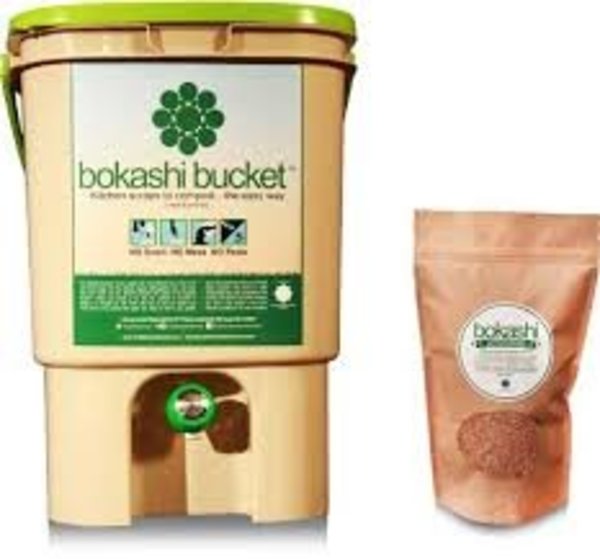For Your Gardening Bucket List: the Bokashi Bucket

Are you an omnivore? If so, then you have omnivore food scraps like meat and dairy, which are big no-nos for the traditional compost bin. But you care about food waste, and you don’t want to throw these scraps in the trash. What to do? Buy a bokashi bucket or, better yet, make your own.
First of all, WTF is a bokashi bucket?
A bokashi bucket is another way to compost food waste.
Like a traditional compost bin, the bokashi bucket uses microbes to release enzymes to aid decomposition. However, a bokashi bucket is an anaerobic composting method (uses no oxygen), which is different from your traditional aerobic compost bin.
What’s not to like?
Oh, bokashi bucket, how I love thee, let me count the ways:
1. No schlepping out to the compost bin. (This is especially good news for those of us who live in cold climates and get tired of putting on a parka, hat, gloves, and snow shoes to get there.)
2. No turning required. I love my outdoor compost bin, but turning it with a pitchfork is a tiresome chore.
3. No odor. When properly maintained, the bokashi bucket should have no unpleasant odor.
4. No mess. The bokashi bucket is a self-contained plastic unit. As long as you can get your kitchen scraps in it without dropping them all over the counter, there shouldn’t be any mess.
5. No pests. Because it is sealed and there is no ugly odor, the bokashi bucket should not attract pests.
6. Good for small spaces. Apartment dwellers rejoice! The bokashi bucket only takes up a few feet of indoor space. It can even be hidden under the kitchen sink.
7. It composts meat and dairy–even bones! There will be even less food waste now that you can not only compost your fruit and veggie scraps but also meat and dairy products. Anything that chips away at the 1.3 billion tons of annual food waste is a good thing.
Note: Oil, paper and plastic, yard waste, and liquids should not go in a bokashi bucket.
8. It produces compost tea! In addition to solid compost that you can bury in your garden, the bokashi bucket will also make compost tea. Dilute it with water (2-3 ounces of tea: 1 gallon of water) and use anywhere you use a liquid fertilizer.
Some folks report that this liquid can have a foul odor once exposed to air. The solution? Use it as soon as possible. Once it’s in soil the odor will dissipate.
10. It’s quick! Food scraps will decompose more quickly–within a few weeks–in the bokashi bucket than other composting methods.
But….
I love everything about the bokashi bucket except the need to continually buy the activator. To me, the activator is the printer ink of the composting world. You know how you buy an office printer at a reasonable price, but then you spend serious bank buying ink cartridges every few months.
Among bokashi bucket gurus this activator is commonly replaced with a combination of EM (Effective Microorganisms) and bokashi bran (wheat bran). There are many recipes out there to make your own EM. Here’s one that I like from Hawaii Healing Tree. You may also be able to find EM at a store that sells supplies for brewing beer or pickling.
How to use the compost
The bokashi bucket will produce two types of compost–liquid and solid.
The solid compost is not finished compost–it hasn’t completed the whole decomposition process. You can bury it in your garden to amend the soil while it finishes decomposing. Do not apply it directly on a plant or its roots because it’s still acidic. Alternatively, you can put the solid compost in an aerobic outdoor compost bin to finish decomposing.

Where to buy
TheBokashiBucket.com sells both the bokashi bucket and the activator powder. They’re not the only option for purchasing a complete bokashi bucket system so shop around to find the right bucket at the right price for you.
Want to make your own?
Making my own bokashi bucket is on my (long) list of garden projects. I may not have done it yet, but other ingenious gardeners have. This guide from the Maine Organic Farmers and Gardeners Association is thorough and easy to understand.
Want a history lesson?
Dr. Teuro Higa, a professor at the University of Ryukyus, Okinawa, Japan, is credited with developing the EM and bokashi bucket as we know it today.
PlanetNatural.com has a more exhaustive history of the bokashi bucket; I found it interesting.
Related on Organic Authority
6 Timely, Frigid Tips For Winter Composting
How To Make Dog Poop Compost That Won’t (Totally) Gross You Out
3 Easy Steps to Worm Composting Bins That Won’t Gross You Out
photo of chicken bones on plate via Shutterstock
photo of bokashi bucket via thebokashibucket.com

